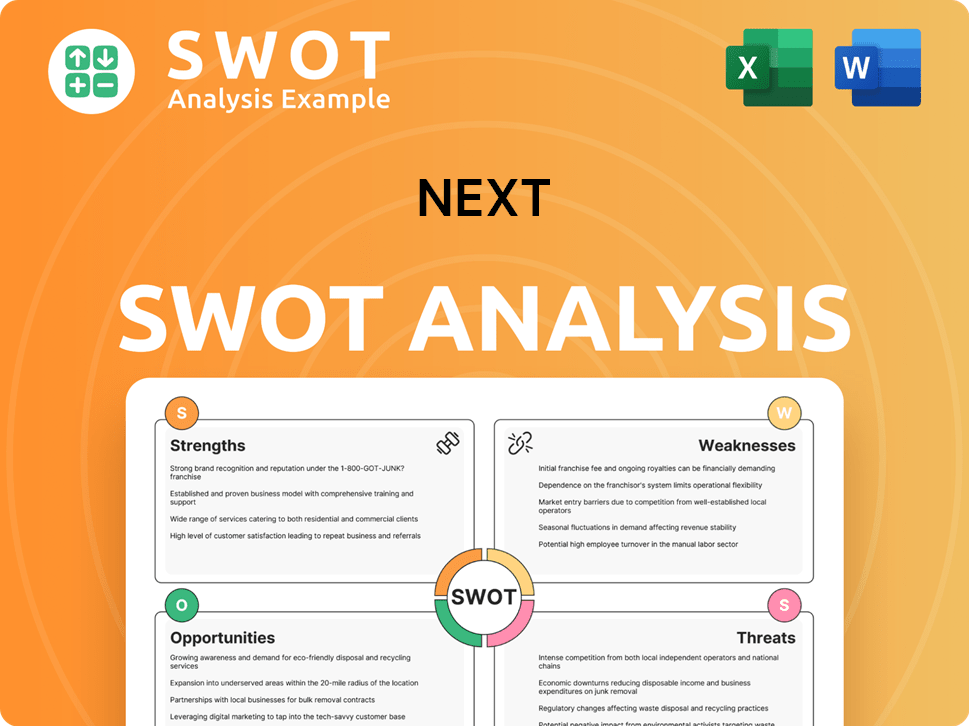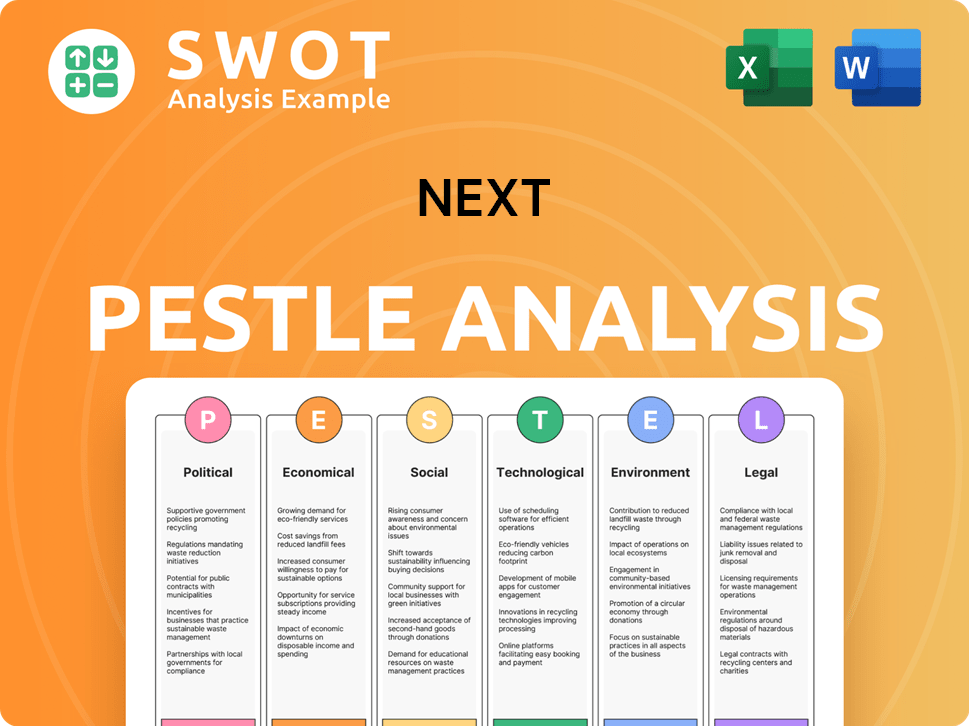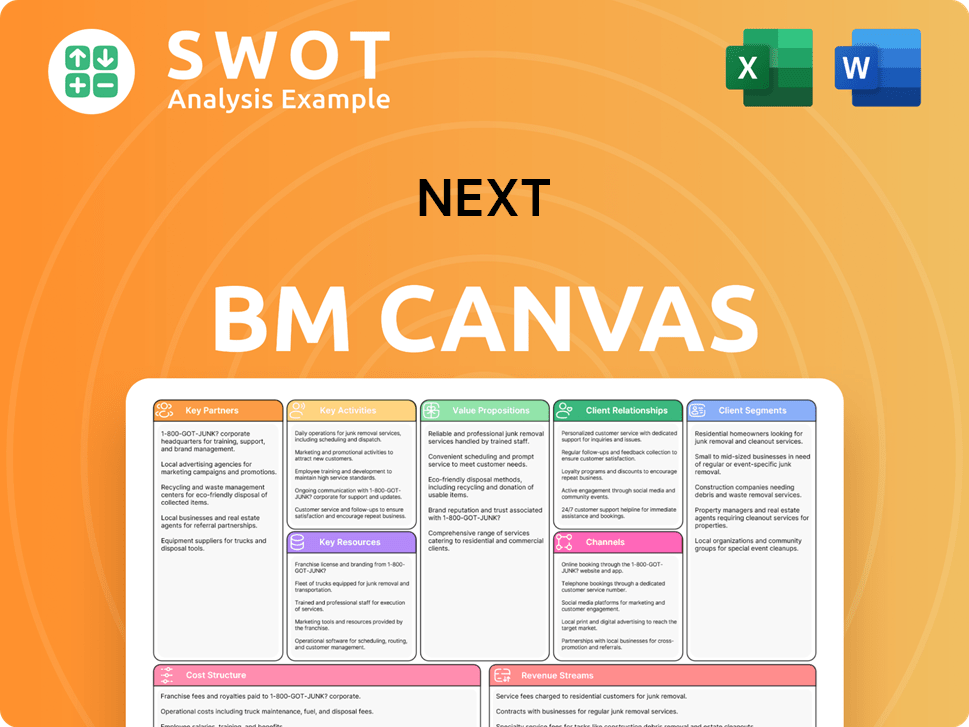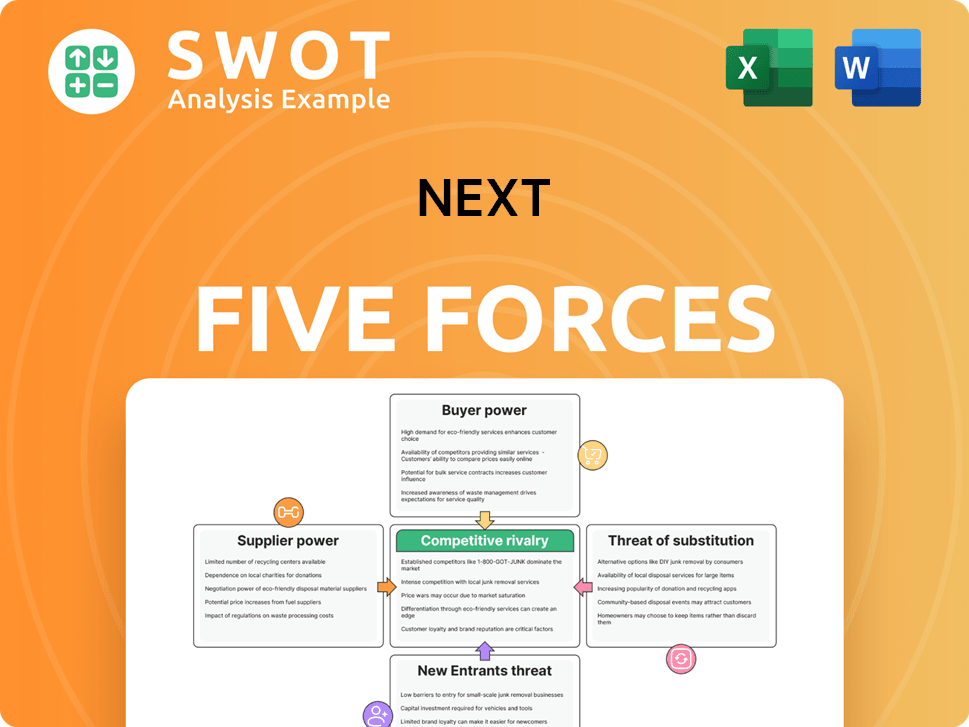Next Bundle
How does Next Company navigate the cutthroat world of retail?
Next plc, a stalwart of the British retail scene, has a rich history dating back to 1864. From its origins as a tailoring business, Next has evolved into a multifaceted retailer, offering clothing, footwear, and home products. Understanding its Next SWOT Analysis is crucial for grasping its strategic positioning in a dynamic market.

To truly understand Next Company analysis, we must delve into its competitive landscape. This exploration of market competition will reveal who the industry rivals are and how Next Company stacks up. Analyzing its competitive advantages and strategic positioning provides critical insights into its ability to thrive amidst evolving market trends and competitive threats. This detailed competitive analysis will help assess Next Company's market share and financial performance compared to its rivals.
Where Does Next’ Stand in the Current Market?
Next plc's core operations center around the retail of clothing, footwear, and home products, primarily within the UK market. The company operates through a multi-channel approach, encompassing physical retail stores, a robust online presence via Next.co.uk, and its long-standing Next Directory catalogue business. This diversified model allows Next to cater to a broad customer base and adapt to evolving consumer shopping preferences. Next's value proposition lies in offering a combination of own-brand products and third-party brands, providing a wide selection of merchandise with a focus on quality and value.
The company’s strategic positioning has evolved, with an increasing emphasis on its online channels and the development of its 'Total Platform'. This platform provides e-commerce and logistics services to other retailers, demonstrating Next's ability to leverage its infrastructure and adapt to the changing retail landscape. This shift towards a more digitally-driven and diversified business model has allowed Next to maintain its market position and drive growth.
Next's financial health continues to be strong. In its full-year results for the year ended January 2024, Next reported a pre-tax profit of £918 million, showcasing its continued profitability and scale within the industry. This financial performance underscores Next's operational efficiency and effective inventory management, which are key factors in its competitive advantages.
Next consistently ranks among the top apparel retailers in the UK, holding a significant market share in clothing, footwear, and home products. While specific real-time market share figures for 2024-2025 are subject to ongoing market dynamics, Next's strong brand recognition and multi-channel presence contribute to its leading position. This strong market position is a key aspect of the Owners & Shareholders of Next.
Next's competitive advantages include its strong brand reputation, diversified retail channels, and efficient supply chain management. The 'Total Platform' initiative allows Next to leverage its infrastructure and provide services to other retailers, enhancing its revenue streams. Furthermore, Next's financial performance, as demonstrated by its profitability, reflects its operational efficiency and effective inventory management.
Next has strategically shifted its positioning to emphasize its online channels and the development of its 'Total Platform'. This move towards a more digitally-driven business model allows Next to adapt to changing consumer shopping habits. Its focus on own-brand products and third-party brands, along with its strong online presence, contributes to its competitive strategy.
Next's financial health remains strong, with a pre-tax profit of £918 million reported for the year ended January 2024. This financial performance demonstrates its continued profitability and operational efficiency. The company's ability to maintain strong financial results is a key indicator of its competitive position and strategic effectiveness.
The competitive landscape for Next includes a mix of online and offline retailers. Key competitors include both established high-street brands and fast-fashion retailers. Next faces challenges in adapting to changing consumer preferences and maintaining its market share in a competitive environment.
- Increased competition from online retailers like ASOS and Boohoo.
- Changing consumer preferences and the rise of fast fashion.
- Economic factors and their impact on consumer spending.
- Maintaining operational efficiency and supply chain management.
Next SWOT Analysis
- Complete SWOT Breakdown
- Fully Customizable
- Editable in Excel & Word
- Professional Formatting
- Investor-Ready Format

Who Are the Main Competitors Challenging Next?
Analyzing the competitive landscape of Next Company reveals a complex environment shaped by diverse rivals. The company faces challenges across multiple fronts, including pricing, innovation, branding, and distribution. Understanding these market competition dynamics is crucial for assessing Next Company's strategic position and future prospects.
The Next Company analysis requires a deep dive into both direct and indirect competitors. Direct competitors operate within similar market segments, offering comparable products or services. Indirect competitors, while not directly offering the same products, can still impact Next Company through alternative offerings or broader market trends.
The competitive dynamics are constantly evolving, driven by changing consumer preferences, economic conditions, and technological advancements. Retailers must continuously adapt their strategies to maintain their market share and profitability. This includes investments in e-commerce, omnichannel capabilities, and innovative engagement strategies.
In the UK clothing and footwear market, Next Company competes with established high-street retailers. Marks & Spencer, with its strong brand loyalty and food business, is a key rival. Primark, known for its low-cost fashion, poses a significant price-based challenge.
Online retailers such as ASOS and Boohoo are significant competitors. These companies capitalize on fast-fashion trends and agile supply chains. They attract younger demographics with extensive product ranges and aggressive marketing strategies.
In the home products sector, Next Company faces competition from specialist home retailers. Dunelm and IKEA offer a wide array of furnishings and decor. Department stores like John Lewis also compete in this space.
Online marketplaces like Amazon represent an indirect but pervasive competitive force. They offer a vast selection of products across all of Next Company's categories. These marketplaces often provide competitive pricing and rapid delivery options.
Market share shifts are driven by changing consumer preferences and economic conditions. The rise of online shopping has significantly impacted traditional brick-and-mortar retailers. Companies like Next Company must invest in e-commerce.
Emerging players using social media and direct-to-consumer models are disrupting the traditional landscape. Established retailers must innovate their engagement strategies. Mergers and acquisitions further intensify competitive dynamics.
The competitive landscape is continually reshaped by strategic moves, technological advancements, and evolving consumer behaviors. For example, the acquisition of online brands by larger retail groups is a common trend. These consolidations create larger, more diversified retail entities, intensifying competition. To gain further insights, consider exploring the Marketing Strategy of Next.
Next Company faces several challenges in maintaining its market position. These challenges include adapting to the rapid growth of e-commerce and responding to changing consumer preferences. Understanding these factors is vital for assessing the company's future prospects.
- E-commerce Growth: The increasing shift towards online shopping requires continuous investment in digital platforms and omnichannel strategies.
- Consumer Preferences: Changing tastes and demand for sustainable and ethical products necessitate product innovation and supply chain adjustments.
- Economic Conditions: Economic downturns and inflation can impact consumer spending. This affects sales and profitability.
- Supply Chain Disruptions: Global events can disrupt supply chains. This can lead to inventory issues and increased costs.
- Market Share: Maintaining or increasing market share against both direct and indirect competitors is a constant battle.
Next PESTLE Analysis
- Covers All 6 PESTLE Categories
- No Research Needed – Save Hours of Work
- Built by Experts, Trusted by Consultants
- Instant Download, Ready to Use
- 100% Editable, Fully Customizable

What Gives Next a Competitive Edge Over Its Rivals?
The competitive landscape for Next Company is shaped by a variety of factors, including its strategic positioning, market competition, and the performance of its industry rivals. A deep dive into Next Company analysis reveals a company that has consistently adapted to the changing retail environment. Understanding the competitive advantages of Next Company is crucial for investors and analysts looking to assess its long-term prospects.
Next's ability to maintain a robust market share highlights its resilience in a dynamic industry. The company's strategic moves and financial performance, when compared to its competitors, provide valuable insights into its strengths and weaknesses. Analyzing Next Company's SWOT analysis, alongside its product comparison with rivals, helps to clarify its position within the market.
This detailed competitive analysis of Next Company will explore its key strengths, the challenges it faces, and how it compares to its main rivals. The following sections will provide a comprehensive overview of Next's competitive advantages, its strategic positioning, and the latest competitive intelligence to assess its market position effectively. For a broader understanding, consider exploring the Growth Strategy of Next.
Next's integrated approach combines physical stores, an online platform (Next.co.uk), and the Next Directory catalogue. This provides customers with flexibility and convenience. Services like click-and-collect leverage the store network, enhancing the shopping experience.
Next has cultivated a loyal customer base through its own-brand clothing, footwear, and home products. The brand is perceived as offering good value for money. This trust extends to its curated selection of third-party brands, boosting its appeal.
Efficient supply chain and inventory management systems enable effective stock control and timely delivery. This is critical in the fast-paced retail environment. These systems contribute significantly to operational strengths.
The 'Total Platform' initiative provides e-commerce, warehousing, and distribution services to third-party brands. This effectively monetizes Next's existing infrastructure. It allows Next to leverage economies of scale and expand its influence.
Next's financial services arm, offering credit and insurance, fosters customer loyalty. This provides an additional revenue stream. The company continually invests in technology and logistics to sustain its advantages.
- The omnichannel strategy allows Next to adapt to changing consumer behaviors.
- Brand reputation and quality are key differentiators in a competitive market.
- Efficient operations and supply chain management reduce costs and improve customer satisfaction.
- The Total Platform initiative generates additional revenue streams.
Next Business Model Canvas
- Complete 9-Block Business Model Canvas
- Effortlessly Communicate Your Business Strategy
- Investor-Ready BMC Format
- 100% Editable and Customizable
- Clear and Structured Layout

What Industry Trends Are Reshaping Next’s Competitive Landscape?
The retail industry is currently undergoing significant transformations, with technological advancements, changing consumer behaviors, and economic shifts reshaping the competitive landscape. This dynamic environment presents both risks and opportunities for companies like Next. Understanding these trends is crucial for assessing Next's strategic positioning and future prospects.
Next faces intense competition from various players, including established retailers, online pure-plays, and discount brands. The company must navigate rising costs, supply chain disruptions, and evolving consumer demands. However, opportunities exist in expanding its e-commerce presence, leveraging its platform, and adapting to sustainability trends. A comprehensive Next Company analysis is essential to understand its competitive advantages and potential challenges.
Technological advancements, such as AI and data analytics, are reshaping retail. Consumers increasingly prefer online shopping and personalized experiences. Regulatory changes and sustainability concerns influence operational practices. Economic shifts, including inflation, impact consumer spending.
Intense competition from online retailers and discounters pressures margins. Rising living costs may reduce discretionary spending. Supply chain disruptions can affect inventory and delivery. Consumer demand for sustainable products requires investment. Understanding the challenges is key in performing a Next Company's SWOT analysis.
Expanding e-commerce market share, especially internationally, is a key opportunity. The 'Total Platform' initiative can create new revenue streams. Leveraging data analytics enhances marketing and customer engagement. Strategic partnerships can unlock new market segments. A focus on sustainability can improve brand reputation.
Next's competitive position is evolving towards a digitally-centric model. The company is focused on leveraging platform services. Maintaining strong brand appeal is crucial for resilience. Continuous adaptation to market trends is essential for long-term success. Learn more about Next's target customers in Target Market of Next.
The competitive landscape for Next is shaped by its ability to adapt to digital transformation, manage supply chain complexities, and respond to consumer preferences. Key factors include e-commerce capabilities, brand reputation, and operational efficiency. Understanding these elements helps in assessing market competition.
- E-commerce Growth: The online retail market is expected to continue growing, with an estimated global e-commerce sales reaching over $6.3 trillion in 2024.
- Sustainability: Consumers are increasingly demanding sustainable products, with a significant rise in demand for eco-friendly options.
- Data Analytics: Utilizing data to personalize customer experiences and optimize operations is a major competitive advantage.
- Supply Chain Resilience: Building resilient supply chains to mitigate disruptions is crucial, especially considering geopolitical events.
Next Porter's Five Forces Analysis
- Covers All 5 Competitive Forces in Detail
- Structured for Consultants, Students, and Founders
- 100% Editable in Microsoft Word & Excel
- Instant Digital Download – Use Immediately
- Compatible with Mac & PC – Fully Unlocked

Related Blogs
- What are Mission Vision & Core Values of Next Company?
- What is Growth Strategy and Future Prospects of Next Company?
- How Does Next Company Work?
- What is Sales and Marketing Strategy of Next Company?
- What is Brief History of Next Company?
- Who Owns Next Company?
- What is Customer Demographics and Target Market of Next Company?
Disclaimer
All information, articles, and product details provided on this website are for general informational and educational purposes only. We do not claim any ownership over, nor do we intend to infringe upon, any trademarks, copyrights, logos, brand names, or other intellectual property mentioned or depicted on this site. Such intellectual property remains the property of its respective owners, and any references here are made solely for identification or informational purposes, without implying any affiliation, endorsement, or partnership.
We make no representations or warranties, express or implied, regarding the accuracy, completeness, or suitability of any content or products presented. Nothing on this website should be construed as legal, tax, investment, financial, medical, or other professional advice. In addition, no part of this site—including articles or product references—constitutes a solicitation, recommendation, endorsement, advertisement, or offer to buy or sell any securities, franchises, or other financial instruments, particularly in jurisdictions where such activity would be unlawful.
All content is of a general nature and may not address the specific circumstances of any individual or entity. It is not a substitute for professional advice or services. Any actions you take based on the information provided here are strictly at your own risk. You accept full responsibility for any decisions or outcomes arising from your use of this website and agree to release us from any liability in connection with your use of, or reliance upon, the content or products found herein.